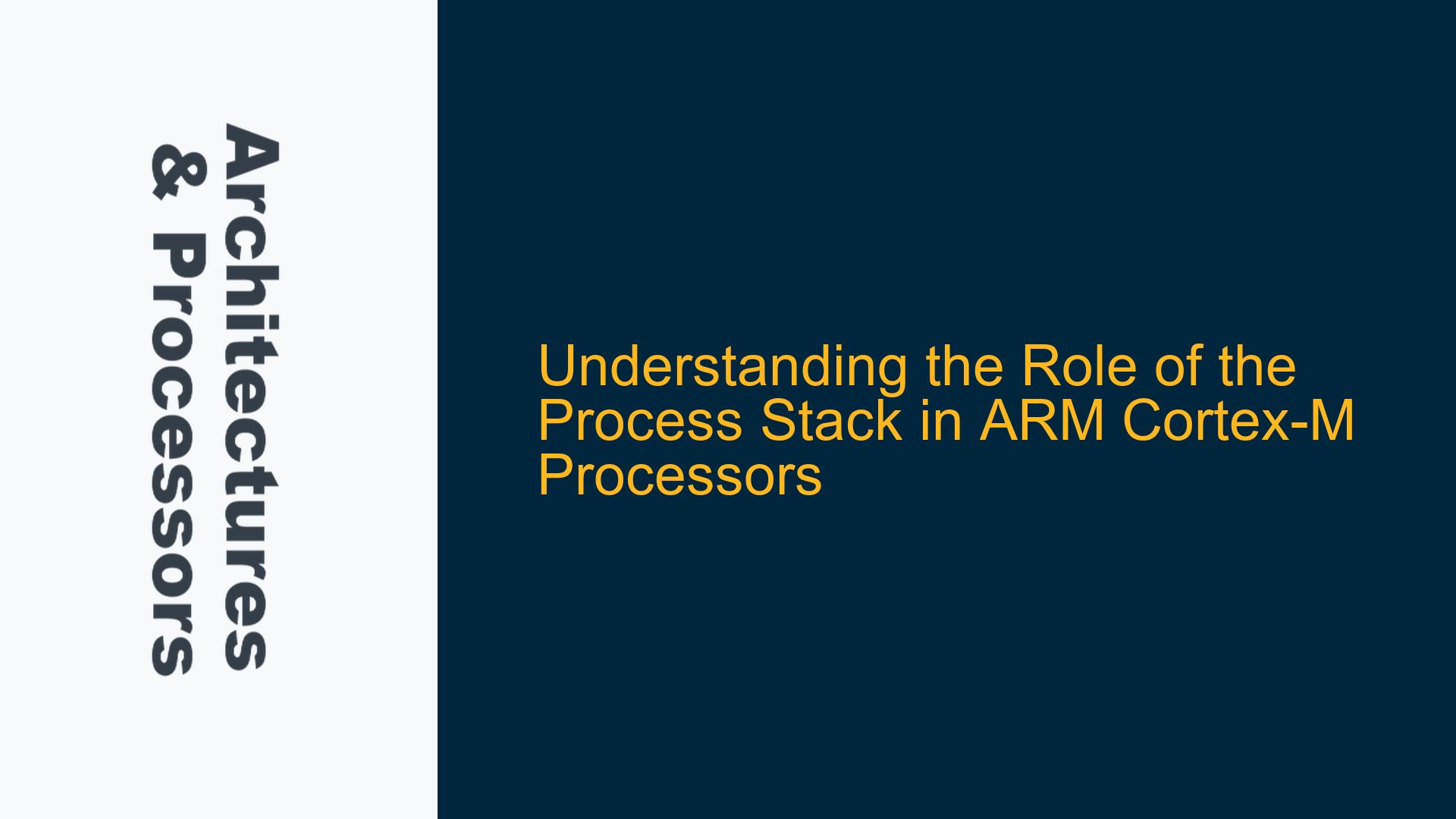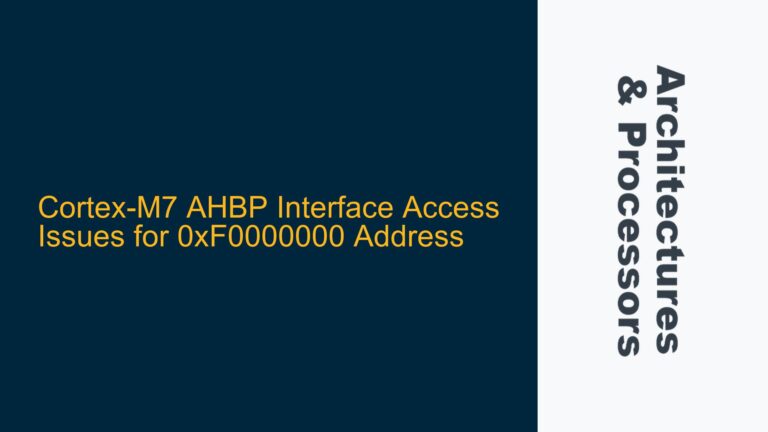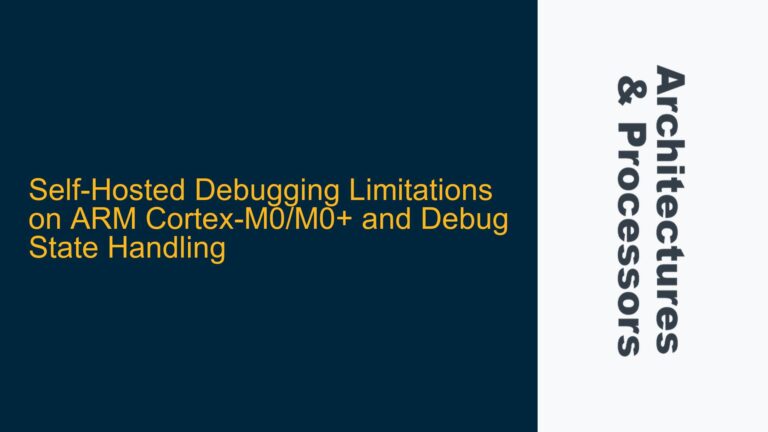ARM Cortex-M Process Stack: Purpose and Architectural Context
The ARM Cortex-M series of processors, widely used in embedded systems, features a unique architectural element known as the process stack. This stack is distinct from the main stack and plays a critical role in the execution environment of the processor. To understand its purpose, we must first delve into the architectural design of the Cortex-M processors, particularly their handling of tasks, threads, and memory management.
Cortex-M processors are designed for real-time, low-power, and deterministic performance, making them ideal for microcontroller applications. Unlike higher-end ARM processors such as those in the Cortex-A series, Cortex-M processors typically lack a Memory Management Unit (MMU). Instead, some variants include a Memory Protection Unit (MPU), which provides limited memory protection but does not support virtual memory or full process isolation. This distinction is crucial because it influences how the processor manages tasks and stacks.
The process stack is specifically designed to handle thread-level execution. In operating systems or environments that support multitasking, such as RTOS (Real-Time Operating Systems), each thread requires its own stack to store local variables, function call return addresses, and other context-specific data. The process stack serves this purpose, allowing multiple threads to operate independently without interfering with each other’s stack space.
The Cortex-M architecture provides two stack pointers: the Main Stack Pointer (MSP) and the Process Stack Pointer (PSP). The MSP is used during system initialization, exception handling, and privileged mode execution, while the PSP is used for thread execution in unprivileged mode. This separation ensures that system-level operations remain isolated from application-level threads, enhancing both security and reliability.
The term "process stack" can be somewhat misleading, as Cortex-M processors do not support processes in the traditional sense (i.e., isolated address spaces managed by an MMU). Instead, the term reflects a broader conceptual framework where "process" refers to any executing entity, whether a thread, task, or subroutine. This naming convention aligns with the historical use of the term in computer science, where "process" often denotes an independent execution context.
Memory Management and Stack Separation in Cortex-M Processors
The absence of an MMU in Cortex-M processors means that they cannot implement full process isolation or virtual memory. However, the separation of the main stack and process stack provides a lightweight mechanism for managing multiple execution contexts. This separation is particularly important in real-time systems, where deterministic behavior and low latency are critical.
The Main Stack Pointer (MSP) is used for system-level operations, including exception handling and interrupt servicing. When an exception occurs, the processor automatically switches to the MSP to ensure that the system stack is used for handling the exception. This guarantees that critical system operations are not disrupted by application-level code.
In contrast, the Process Stack Pointer (PSP) is used for application-level threads. Each thread has its own process stack, which is allocated in memory and managed by the operating system or runtime environment. When a thread is scheduled to run, the PSP is updated to point to the thread’s stack, allowing it to execute independently of other threads.
This dual-stack mechanism provides several benefits:
- Isolation: By separating the system stack from the process stack, the Cortex-M architecture ensures that system-level operations are not affected by application-level code. This isolation is critical for reliability and security, particularly in safety-critical systems.
- Efficiency: The use of separate stacks reduces the overhead associated with context switching. Since each thread has its own stack, there is no need to save and restore the entire stack during a context switch. Instead, only the PSP needs to be updated.
- Flexibility: The dual-stack design allows for a wide range of multitasking models, from simple cooperative multitasking to preemptive multitasking with priority-based scheduling.
Despite these advantages, the lack of an MMU means that Cortex-M processors are limited in their ability to support full process isolation. This limitation is offset by the use of an MPU in some Cortex-M variants, which provides basic memory protection by defining regions of memory that can be accessed by specific threads or tasks.
Practical Implications and Best Practices for Using the Process Stack
Understanding the role of the process stack in Cortex-M processors is essential for developing efficient and reliable embedded systems. Here are some practical considerations and best practices for working with the process stack:
-
Stack Allocation: Ensure that each thread has sufficient stack space to handle its worst-case stack usage. Insufficient stack space can lead to stack overflow, which can corrupt memory and cause unpredictable behavior. Use tools such as stack analysis utilities to determine the maximum stack usage for each thread.
-
Context Switching: When implementing a multitasking system, carefully manage the PSP during context switches. Update the PSP to point to the new thread’s stack before resuming execution. This ensures that each thread operates independently and does not interfere with other threads’ stack space.
-
Exception Handling: Be aware that exceptions and interrupts always use the MSP. This means that any local variables or data stored on the process stack will not be accessible during exception handling. If necessary, copy critical data from the process stack to a shared memory area before entering an exception handler.
-
Memory Protection: If your Cortex-M variant includes an MPU, use it to define memory regions for each thread’s stack. This prevents threads from accessing each other’s stack space, enhancing security and reliability. Configure the MPU to generate a fault if a thread attempts to access memory outside its allocated region.
-
Debugging: Use debugging tools to monitor stack usage and detect stack overflow conditions. Many development environments provide stack usage analysis features that can help identify potential issues before they cause system failures.
-
Naming Conventions: While the term "process stack" is used in the Cortex-M architecture, it is important to recognize that it refers to thread-level execution contexts. Avoid confusion by clearly documenting the purpose of each stack in your system and using consistent terminology in your code and documentation.
By following these best practices, you can leverage the process stack effectively in your Cortex-M-based embedded systems, ensuring efficient and reliable operation. The dual-stack architecture of the Cortex-M processors provides a robust foundation for multitasking and real-time operation, making it a powerful choice for a wide range of embedded applications.
In conclusion, the process stack in ARM Cortex-M processors is a critical architectural feature that enables efficient and reliable multitasking in embedded systems. Its separation from the main stack ensures system-level operations remain isolated from application-level threads, while its use in thread execution provides flexibility and efficiency. By understanding its purpose and implementing best practices, developers can fully harness the capabilities of the Cortex-M architecture in their designs.






